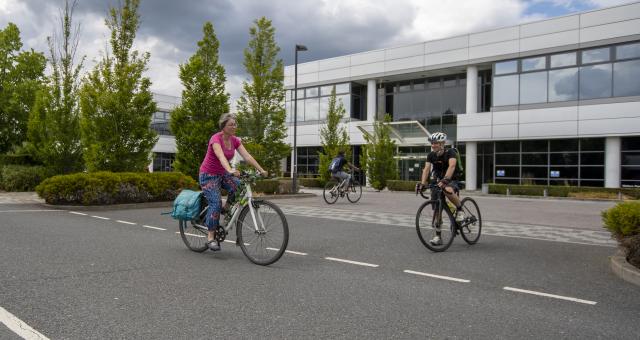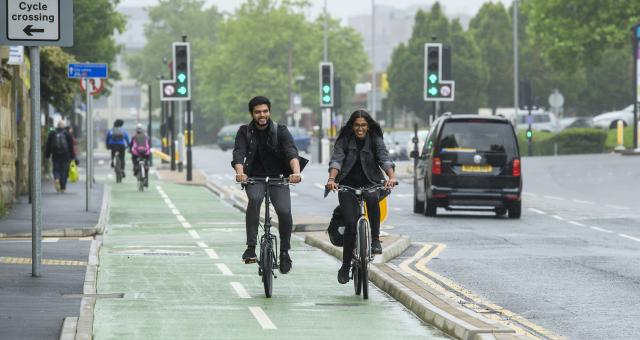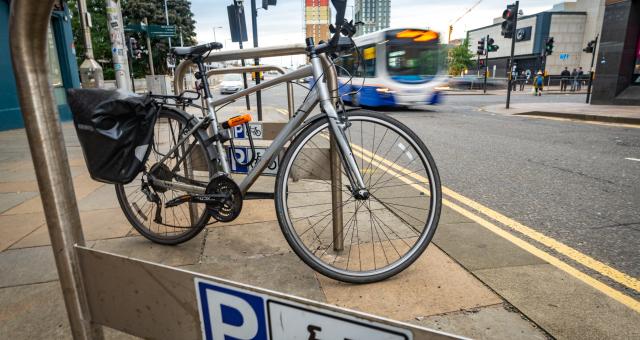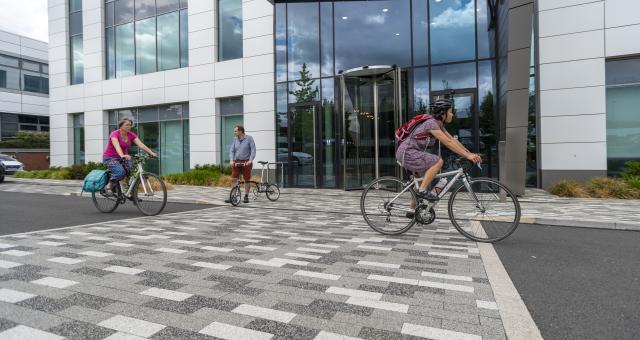How to set up a cycling group at work

Cycling groups at work, otherwise known as Bicycle User Groups (BUGs), are a fantastic way to support cycle commuters and staff looking to start to cycle to work, or even to meetings or between work places. They are usually championed by a regular cycle commuter and include a group of cycling colleagues.
Some BUGs have much in common with local cycle campaign groups, by promoting cycling. Many not only look after the interests of existing cyclists, but also work hard to encourage other employees to take up cycling too.
Workplaces that support cycling benefit in many ways, from supporting their staff’s health and wellbeing to reducing car parking costs. Find out more about how your organisation can become a Cycle Friendly Employer.
Getting started
If you’re looking to campaign for better facilities at work, here are some tips on how to set up a BUG:
- Share and discuss your ideas with other cyclists at your workplace first. If you don’t know who they are, attach leaflets to their bicycles or put up a poster near any cycle parking – or just send out an email to everyone, if possible.
- Arrange a meeting for anyone who’s interested and let your employer know beforehand.
- At the meeting, take everyone’s contact details. Ask them how involved they want to be and if they have any special skills the BUG could use (design, writing newsletters, diplomacy etc). Discuss your cycling wish list and work out the priorities.
- Start with some simple, clear-cut objectives, such as a 20p mileage rate for employees cycling on business (this is the permitted Inland Revenue rate for tax relief); covered cycling parking; showers and a drying room.
- Research the above, estimate costs, and gather literature/leaflets to persuade your employer that promoting cycling has something in it for them as well, including healthier staff, fewer costly car parking places, less congestion on the roads, among others. Cycling UK’s guide to becoming a cycle-friendly employer explains the benefits.
- Work out who in your management structure should be able to help put your proposals into practice. Meet them, perhaps offering a presentation. Be constructive and well-informed and, above all, do your best to come out with managerial endorsement plus timetabled action points and, ideally, a budget. If your group is big, let them know – it demonstrates the popularity of your proposal.
What you’ll need
- Champion(s) committed to supporting their colleagues to cycle to work.
- An open, approachable and friendly group.
- Someone to take care of organising the weekly meetings.
- Support from both non-managerial and managerial staff – and ‘top bods’.
- Lots of reliable and accessible sources of information and advice – Cycling UK can help you with this so please get in touch and let us know what you need.
- Good publicity and promotion around your cycling group and cycling to work.
- Momentum and passion to keep it active and fun.

Build a buddy scheme
One of the best ways you can encourage others to cycle to work is by developing a buddy scheme. This is where a person from work who regularly cycles, supports another employee to give it a try. They can do this by cycling in together or helping a new rider to map their route(s).
It’s a great way to build confidence and support others to cycle to work, especially those who are nervous when cycling on roads. To get this set up all you need to do is map out who lives close to whom and is willing to sign up to the scheme.
Find someone to help with bike repair and maintenance
Hopefully there will be some people in your group who are skilled in bike maintenance. It is worth making sure you know who these are early on. They can become useful assets when teaching others how to fix their bikes and may even help you fix yours.
Keep cycling social
Cycling is a good way to socialise with colleagues at work and promote health and wellbeing. Here are a few ideas of what your cycling group could organise:
- Regular lunchtime rides.
- After-work rides.
- Workplace challenges – such as taking part in Bike Week’s #7daysofcycling or Cycle to Work Day.
- A staff leader board.
Promoting cycling in your workplace
Here are a few ideas on what your group can do to increase cycling among your colleagues and staff and to publicise the BUG.
Admin and publicity
- Set up and maintain a database or spreadsheet of cycle commuters; and register any skills that might be useful to the cycling group.
- Design a logo.
- Produce posters and a regular newsletter; publicise your successes.
- If your company has an intranet use it to promote the group.
- Set up a central notice board, leaflet stand or suggestion box.

Keep in regular communication with the cycling community at work and beyond
- Arrange regular meetings, both with relevant managers and cycling group members.
- Contact whoever is responsible for cycling at your local council. They may be able to help with any road engineering issues you have, or tell you about any work they’re doing on workplace travel plans. Invite them to address a cycling group meeting.
- Find out if there is a local Cycling UK campaigner and/or cycle campaign group and your BUG involved.
Resources and research
- Collect a library of books, leaflets and information on:
- cycle training;
- the local area (procure an appropriate local map – if none is available, draw one!);
- train timetables and information on cycle carriage;
- tax incentives for both employees and employer alike;
- cycle maintenance;
- load carrying, cycle lighting and other equipment.
- Find out more about your workforce via a cycling survey. What’s stopping more people from cycling? How can the cycling group help?
- Carry out a survey of your premises and surrounds – are there any access or infrastructure problems for cyclists? Are they fixable, and if so, how?
Encouraging other people to cycle
- Contribute to the development of a staff or company travel plan.
- Share Cycling UK’s advice on cycling to work.
- Help arrange for the provision of pool bikes, along with related cycling equipment.
- Investigate your company’s willingness to subscribe to the Cycle to Work scheme, which offers employers of all sizes across the public, private and voluntary sectors a tax-exempt cycle and cycle equipment loan scheme for staff.
- Develop incentives, such as vouchers or discounts at local bike shops.
- Assess the need for cycle parking, lockers, showers, drying room, and work with your employer to supply them.
- Arrange events, such as cycling breakfasts, led rides, cycle maintenance sessions (your local bike shop might help) and presentations.
- Consider getting your organisation accredited as a Cycle Friendly Employer






